EDG2
| Endothelial differentiation, lysophosphatidic acid G-protein-coupled receptor, 2 | |||||||||||
|---|---|---|---|---|---|---|---|---|---|---|---|
| Identifiers | |||||||||||
| Symbols | EDG2 ; Gpcr26; LPA1; LPAR1; Mrec1.3; edg-2; rec.1.3; vzg-1 | ||||||||||
| External IDs | Template:OMIM5 Template:MGI HomoloGene: 1072 | ||||||||||
| |||||||||||
| RNA expression pattern | |||||||||||
 | |||||||||||
 | |||||||||||
 | |||||||||||
| More reference expression data | |||||||||||
| Orthologs | |||||||||||
| Template:GNF Ortholog box | |||||||||||
| Species | Human | Mouse | |||||||||
| Entrez | n/a | n/a | |||||||||
| Ensembl | n/a | n/a | |||||||||
| UniProt | n/a | n/a | |||||||||
| RefSeq (mRNA) | n/a | n/a | |||||||||
| RefSeq (protein) | n/a | n/a | |||||||||
| Location (UCSC) | n/a | n/a | |||||||||
| PubMed search | n/a | n/a | |||||||||
EDG2 (endothelial differentiation gene 2) is a human gene which encodes a G protein-coupled receptor which binds the lipid signaling molecule lysophosphatidic acid (LPA). Hence this receptor is also known as LPA1.[1]
The integral membrane protein encoded by this gene is a lysophosphatidic acid (LPA) receptor from a group known as EDG receptors. These receptors are members of the G protein-coupled receptor superfamily. Utilized by LPA for cell signaling, EDG receptors mediate diverse biologic functions, including proliferation, platelet aggregation, smooth muscle contraction, inhibition of neuroblastoma cell differentiation, chemotaxis, and tumor cell invasion. Alternative splicing of this gene has been observed and two transcript variants have been described, each encoding identical proteins. An alternate translation start codon has been identified, which results in isoforms differing in the N-terminal extracellular tail. In addition, an alternate polyadenylation site has been reported.[1]
See also
References
Further reading
- An S, Goetzl EJ, Lee H (1999). "Signaling mechanisms and molecular characteristics of G protein-coupled receptors for lysophosphatidic acid and sphingosine 1-phosphate". J. Cell. Biochem. Suppl. 30-31: 147–57. PMID 9893266.
- Contos JJ, Ishii I, Chun J (2001). "Lysophosphatidic acid receptors". Mol. Pharmacol. 58 (6): 1188–96. PMID 11093753.
- Hecht JH, Weiner JA, Post SR, Chun J (1997). "Ventricular zone gene-1 (vzg-1) encodes a lysophosphatidic acid receptor expressed in neurogenic regions of the developing cerebral cortex". J. Cell Biol. 135 (4): 1071–83. PMID 8922387.
- Moolenaar WH, Kranenburg O, Postma FR, Zondag GC (1997). "Lysophosphatidic acid: G-protein signalling and cellular responses". Curr. Opin. Cell Biol. 9 (2): 168–73. PMID 9069262.
- An S, Dickens MA, Bleu T; et al. (1997). "Molecular cloning of the human Edg2 protein and its identification as a functional cellular receptor for lysophosphatidic acid". Biochem. Biophys. Res. Commun. 231 (3): 619–22. doi:10.1006/bbrc.1997.6150. PMID 9070858.
- Fukushima N, Kimura Y, Chun J (1998). "A single receptor encoded by vzg-1/lpA1/edg-2 couples to G proteins and mediates multiple cellular responses to lysophosphatidic acid". Proc. Natl. Acad. Sci. U.S.A. 95 (11): 6151–6. PMID 9600933.
- An S, Bleu T, Zheng Y, Goetzl EJ (1998). "Recombinant human G protein-coupled lysophosphatidic acid receptors mediate intracellular calcium mobilization". Mol. Pharmacol. 54 (5): 881–8. PMID 9804623.
- Cervera P, Tirard M, Barron S; et al. (2002). "Immunohistological localization of the myelinating cell-specific receptor LP(A1)". Glia. 38 (2): 126–36. PMID 11948806.
- Hama K, Bandoh K, Kakehi Y; et al. (2002). "Lysophosphatidic acid (LPA) receptors are activated differentially by biological fluids: possible role of LPA-binding proteins in activation of LPA receptors". FEBS Lett. 523 (1–3): 187–92. PMID 12123830.
- Van Leeuwen FN, Olivo C, Grivell S; et al. (2003). "Rac activation by lysophosphatidic acid LPA1 receptors through the guanine nucleotide exchange factor Tiam1". J. Biol. Chem. 278 (1): 400–6. doi:10.1074/jbc.M210151200. PMID 12393875.
- Strausberg RL, Feingold EA, Grouse LH; et al. (2003). "Generation and initial analysis of more than 15,000 full-length human and mouse cDNA sequences". Proc. Natl. Acad. Sci. U.S.A. 99 (26): 16899–903. doi:10.1073/pnas.242603899. PMID 12477932.
- Murph MM, Scaccia LA, Volpicelli LA, Radhakrishna H (2004). "Agonist-induced endocytosis of lysophosphatidic acid-coupled LPA1/EDG-2 receptors via a dynamin2- and Rab5-dependent pathway". J. Cell. Sci. 116 (Pt 10): 1969–80. doi:10.1242/jcs.00397. PMID 12668728.
- Shida D, Kitayama J, Yamaguchi H; et al. (2003). "Lysophosphatidic acid (LPA) enhances the metastatic potential of human colon carcinoma DLD1 cells through LPA1". Cancer Res. 63 (7): 1706–11. PMID 12670925.
- Matsuda A, Suzuki Y, Honda G; et al. (2003). "Large-scale identification and characterization of human genes that activate NF-kappaB and MAPK signaling pathways". Oncogene. 22 (21): 3307–18. doi:10.1038/sj.onc.1206406. PMID 12761501.
- Xu J, Lai YJ, Lin WC, Lin FT (2004). "TRIP6 enhances lysophosphatidic acid-induced cell migration by interacting with the lysophosphatidic acid 2 receptor". J. Biol. Chem. 279 (11): 10459–68. doi:10.1074/jbc.M311891200. PMID 14688263.
- Komuro Y, Watanabe T, Kitayama J; et al. (2004). "The Immunohistochemical expression of endothelial cell differentiation gene-2 receptor in human colorectal adenomas". Hepatogastroenterology. 50 (54): 1770–3. PMID 14696401.
- Ota T, Suzuki Y, Nishikawa T; et al. (2004). "Complete sequencing and characterization of 21,243 full-length human cDNAs". Nat. Genet. 36 (1): 40–5. doi:10.1038/ng1285. PMID 14702039.
- Kaneider NC, Lindner J, Feistritzer C; et al. (2005). "The immune modulator FTY720 targets sphingosine-kinase-dependent migration of human monocytes in response to amyloid beta-protein and its precursor". FASEB J. 18 (11): 1309–11. doi:10.1096/fj.03-1050fje. PMID 15208267.
External links
- IUPHAR GPCR Database - Lysophospholipid receptors
- Lysophospholipid+receptors at the US National Library of Medicine Medical Subject Headings (MeSH)
This article incorporates text from the United States National Library of Medicine, which is in the public domain.
| Stub icon | This membrane protein–related article is a stub. You can help Wikipedia by expanding it. |